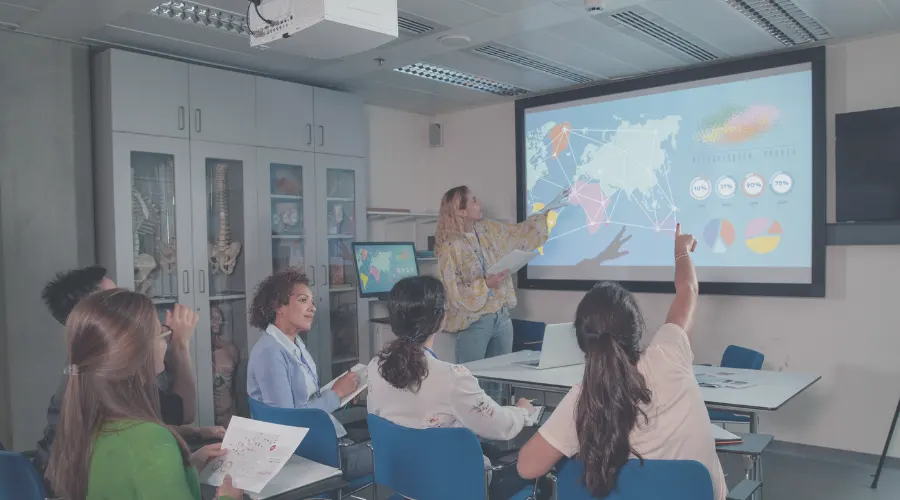I still keep in mind that to begin with time I had to make an introduction as a student. I had no idea where to begin, and like many others, I turned to PowerPoint, as it seemed to be the go-to option for everyone.
The result was basic at best, and honestly, I found myself bored with the process before I even got halfway through.
It wasn’t until I explored other tools that I realized creating presentations didn’t have to be a dull task. With the right software, you can enjoy making something that stands out.
Over time, I discovered various presentation software options that were not only more fun to use but also helped me express my ideas more creatively.
Whether you’re a student preparing for a class presentation, a group project, or even a speech, having the right software can make a huge difference in how effectively you communicate your message.
In this article, I’ll share the best introduction program for students. I’ll also share my personal experiences with each tool, along with tips on how they can help make your presentations more engaging and easier to create.
10 Awesome Presentation Software for Students

1. Microsoft PowerPoint
We can’t talk about presentation software without mentioning Microsoft PowerPoint. While I first found it to be a bit basic, over the years I learned that PowerPoint is a versatile tool that can be much more than just a platform for simple slides.
One day, while working on a science project, I realized I could integrate videos, animations, and dynamic transitions into my presentation.
The result was much more engaging than the simple slides I had started with. PowerPoint allows you to create anything from straightforward slide decks to intricate multimedia presentations.
For students, PowerPoint is an excellent choice because it’s widely available and integrates seamlessly with other Microsoft tools like Word and Excel. Plus, the familiarity makes it a great starting point for beginners.
2. Google Slides
When I first started using Google Slides, it was for a group project. What stood out to me was the ability to collaborate with others in real-time.
My classmates and I could work on our presentation simultaneously, even though we were in different locations.
Google Slides is the portion of Google Workspace, which implies it’s cloud-based and available from any gadget with a web association.
For students working on group projects, this is a huge advantage—no more emailing PowerPoint records back and forward or stressing around adaptation control.
What’s also great about Google Slides is that it’s free to use, and it has a simple interface that’s easy to navigate. If you need to create a presentation quickly and efficiently, Google Slides is a solid option.
3. Canva
The first time I used Canva for a presentation, I was amazed at how beautiful my slides turned out. Canva is known for its plan capabilities, and it has a wide run of formats that make your introduction seem proficient with negligible effort.
For students who might not have a design background, Canva is incredibly user-friendly. You can drag and drop elements, choose from pre-designed layouts, and even access a library of free images and icons. This makes it easy to create visually stunning presentations that stand out from the crowd.
During one of my art classes, I used Canva to create a presentation about famous painters, and the clean, vibrant slides helped me convey the message more effectively. If you’re an understudy who values imagination and planning, Canva is an incredible choice.
4. Prezi
I’ll concede, to begin with, the time I saw a Prezi introduction, I was blown absent. Prezi is interesting since it doesn’t take after the conventional slide-to-slide format. Instead, it employments a zooming interface that permits you to explore through your introduction in a non-linear way.
When I had to give a presentation about history, I used Prezi to create a visual journey through different periods.
The zooming and panning features allowed me to keep my audience engaged, and it also helped them follow the flow of information more dynamically.
Prezi is ideal for students who want to present their ideas in a more interactive and engaging format. It takes a bit of time to get used to, but the result is always worth it.
5. Keynote
When I switched to a Mac, I started using Keynote, and it quickly became one of my favorite presentation tools.
Keynote offers a smooth and advanced plan, which immediately raises the quality of your introductions. The activities and moves are unimaginably smooth, and the interface is natural.
One of my most memorable experiences with Keynote was when I used it for a class presentation on environmental science.
The built-in features allowed me to create visually compelling slides without spending too much time on design. Furthermore, the smooth moves between slides made the whole introduction feel more polished.
For Mac users, Keynote is an excellent choice. It’s included for free with Apple devices, and it offers powerful features without being overwhelming.
6. Haiku Deck
When I was first introduced to Haiku Deck, I was intrigued by its simplicity. Haiku Deck is planned for those who need to make outwardly engaging introductions rapidly and effectively.
It limits the amount of text you can include on each slide, which encourages you to focus on key points rather than overwhelming your audience with information.
During a literature class, I used Haiku Deck to create a presentation on a novel analysis. By focusing on visuals and keeping text to a minimum, I found that my classmates were more engaged with the presentation.
Haiku Deck is a great choice for students who want to keep things simple and visually impactful.
7. Visme
Visme software is another excellent presentation tool that I discovered while working on a business class project. It offers a wide range of templates and allows for the creation of not just presentations, but also infographics, reports, and social media graphics.
What I loved about Visme was the level of customization it offered. I was able to include interactive elements, charts, and animations that made my presentation stand out. If you’re a student looking for a more advanced presentation tool that offers versatility, Visme is worth exploring.
Visme is particularly useful for students in fields like marketing, business, and data analysis, where visuals and interactivity can enhance your presentation.
8. Adobe Spark
AdobeSpark presentation software was a game-changer for me. When I was looking for a way to create stunning presentations without having to dive deep into complicated design software like Adobe Illustrator or Photoshop.
Adobe Spark offers an easy-to-use interface that allows you to create professional-looking presentations with ease.
One time, I had to present on a photography project, and Adobe Spark allowed me to integrate images and videos seamlessly. The result was a visually captivating presentation that reflected the aesthetic of my project.
If you’re a student with a creative flair, Adobe Spark is a fantastic option for making presentations that are both beautiful and functional.
9. Powtoon
Powtoon was a tool I discovered when I wanted to add animation to a presentation. Unlike traditional presentation software, Powtoon allows you to create animated videos.
I used it for a science project on the solar system, and the animated characters and visuals made the topic more engaging and fun for my classmates.
Powtoon is great for students who want to take a more creative approach to their presentations. It’s especially useful for explaining complex concepts in a way that’s easy to understand and visually appealing.
10. Zoho Show
Zoho Show is another cloud-based presentation tool that I’ve used for group projects. What I appreciate most about Zoho Show is that it offers a wide range of features while remaining user-friendly. You can collaborate with others, integrate media, and even publish your presentation online for easy sharing.
One of the best experiences I had with the Zoho Show was during a group project where we had to create a presentation on global economics. The ability to work on the presentation together in real time made the process much smoother, and the final product was professional and polished.
FAQs
Google Slides is often the best choice for group projects because of its real-time collaboration features. Students can work on the presentation simultaneously from different locations, making it easier to divide tasks and ensure everyone contributes equally.
Suggested read:

